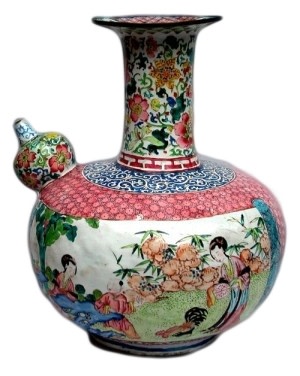With a large bulbous body, widely flaring rim and a bulging globular spout, richly painted in famille rose enamels with two panels in the form of unfurled scrolls reserved against a background of pink honey comb and on the lower half of the body, a white scrolling pattern with white and green flower heads on a dark red background; each scroll-like panel enamelled with a scene of two ladies and a boy at leisure, one lady standing, dressed in pink and blue robes, her hair neatly held together by a jewelled band, holding a fan and a small shawl in her hand, watching a cockerel with long black feathers pecking at the ground, in the background rocks with plants issuing and growing bamboo leaves, another lady sitting by stylised rockwork wearing a long pink robe and a similar jewelled head dress, in front of her a little boy stands, dressed also in pink, with his arm resting on the rock, looking at her, to the side of the seated lady a saucer dish filled with finger citrus placed on rockwork in front of a plantain tree which long leaves stretches over the lady, the scroll ends each rolled in slightly revealing the back of the scroll enamelled with a pattern of flowered diamond work divided in the middle and at both ends with cartouches of phoenix in flight, the two scrolled panels joined by two lotus shaped cartouches, one enamelled with a large peony, a finger citrus and a flower in bud, the other again with a peony, two finger citrus and a small blue flower, around the shoulder a wide band of scroll work on a blue background below a band of key pattern at the base of the neck, the neck brightly enamelled with peonies in full bloom, finger citrus, a flower with blue petals and a yellow centre, another with green and pink petals, on stems, buds of flowers and unusually a yellow and red tiger lily, around the outside rim a band in light green, on the inside of the rim a band with three cartouches enamelled with pink flower heads, finger citrus and other fruits all on a background of flowered diamond pattern in pink, the bulbous spout similarly decorated as the neck with large flower heads of peonies, pink flowers and scrolling branches, the narrowed end of the spout with a band of blue scrollwork, around the footrim a single blue line, the base glazed and enamelled in the centre with a blue stylised flower head.
Literature
The technique of painting in colours on enamel metals is an example of the exchange between the East and the West. Through the knowledge and under the direction of Jesuit Missionaries, instructed in the fashion of enamelling by the workshops at Limoges, and employed at the palace workshops of Emperor Kangxi, the technique was further developed with recent research having the first production of painted enamels in Canton well before 1730, probably in the latter half of the 17th Century. In his Histoire de L?Art Chinois de L?Antiquite jusque a Nos Jours (1928) the French scholar George Soulie de Morant establishes 1683 as the date of first manufacture of painted enamels in Guangzhou ?according to the technique of the Limoges enamels?. The process requires an object of bronze, copper, silver or gold which is then coated with a white enamel, similar to the ceramic glaze, but made white probably by the addition of arsenic to the paste. The object is then fired at a low temperature which secures the glaze and makes it ready for its second stage. The decorations are painted with metallic coloured glazes applied sometimes within a prepared fine engraved line. The object is now fired a second time at a low temperature and finally any gold or black is added, along with the gilding of the rims and the mounts. Objects with European scenes, probably copied from 17th Century prints are sometimes quite clumsy in their construction, with the white paste very thickly added to provide solidity for the painting, but often painted in very bright enamels, dominated by a brownish red with green, yellow and mauve. When occasionally the enamels misfired, some colours, especially the blue could appear to leave a powdery and granular texture on the surface.

